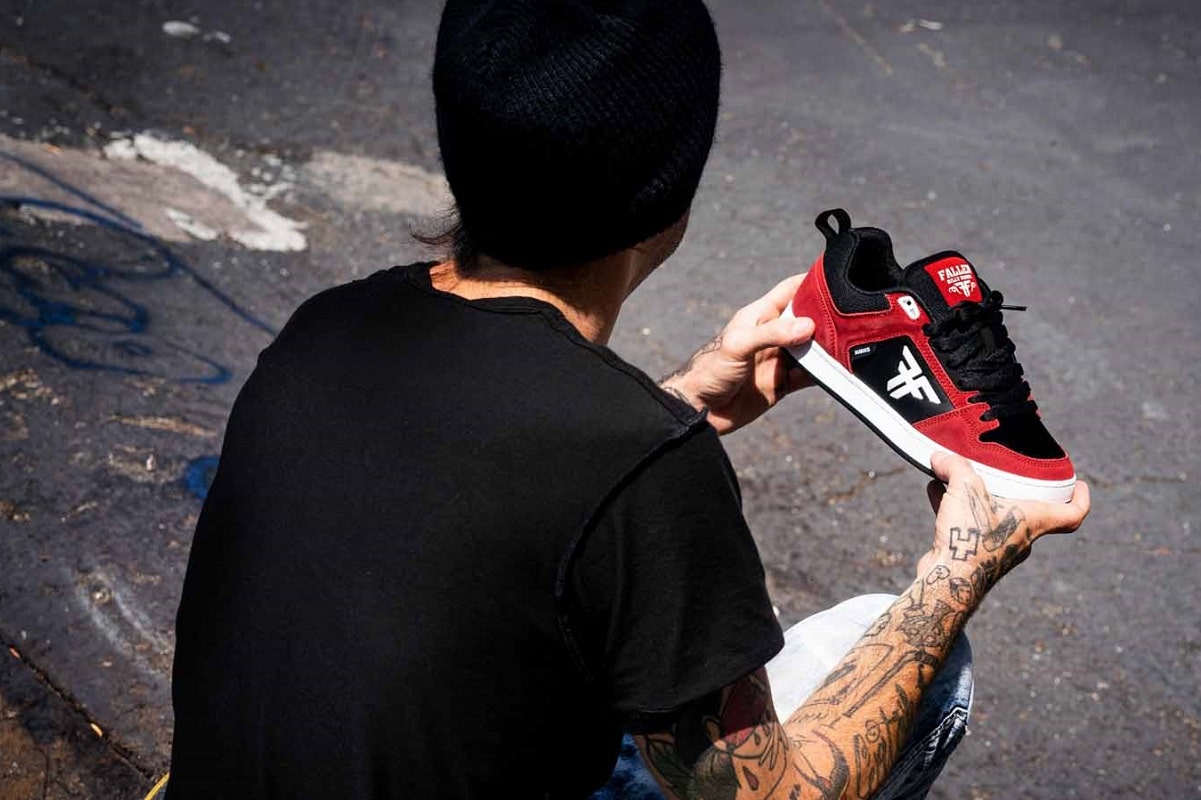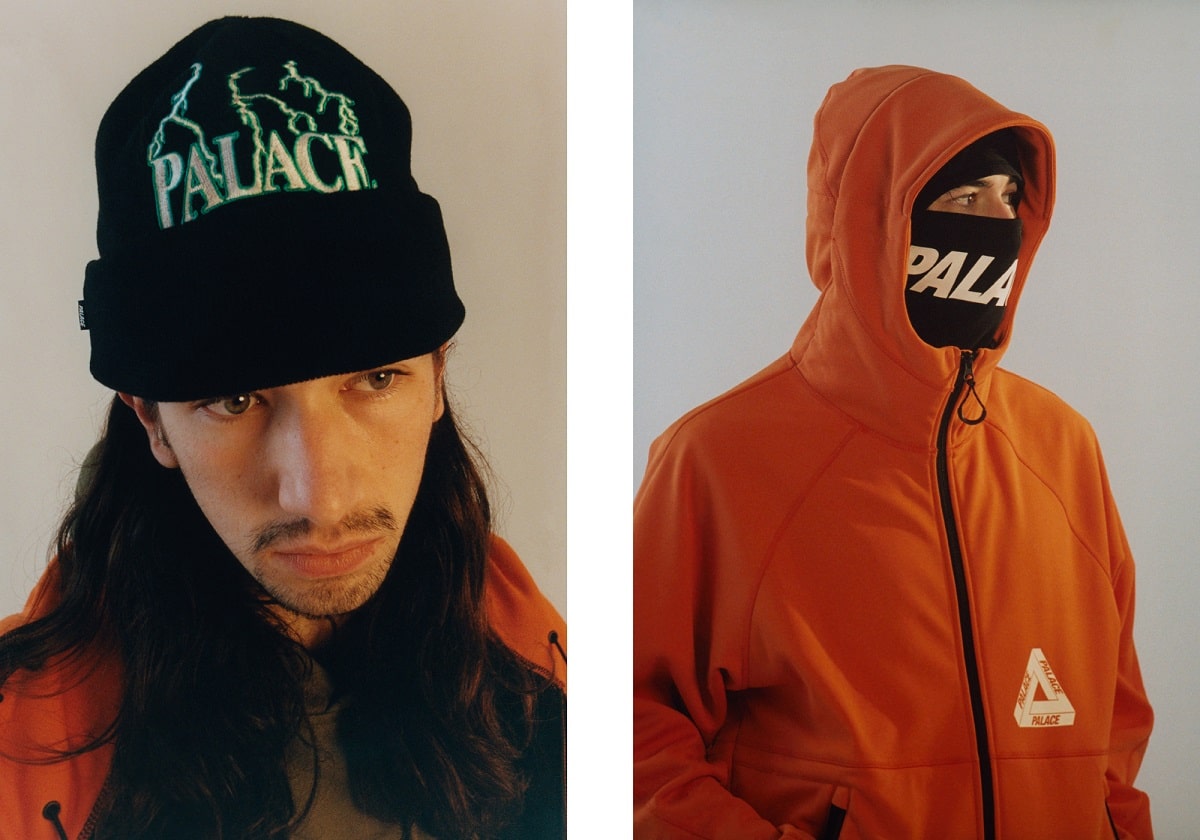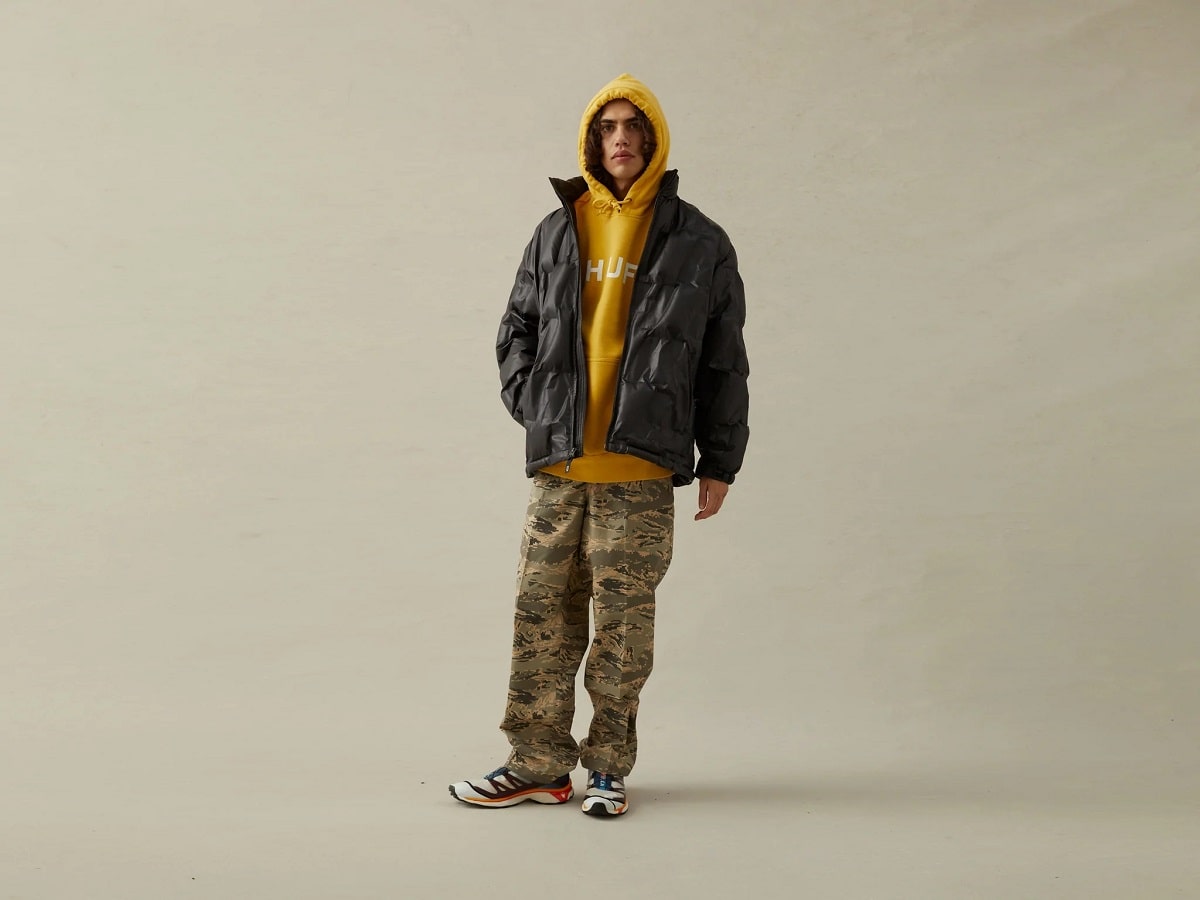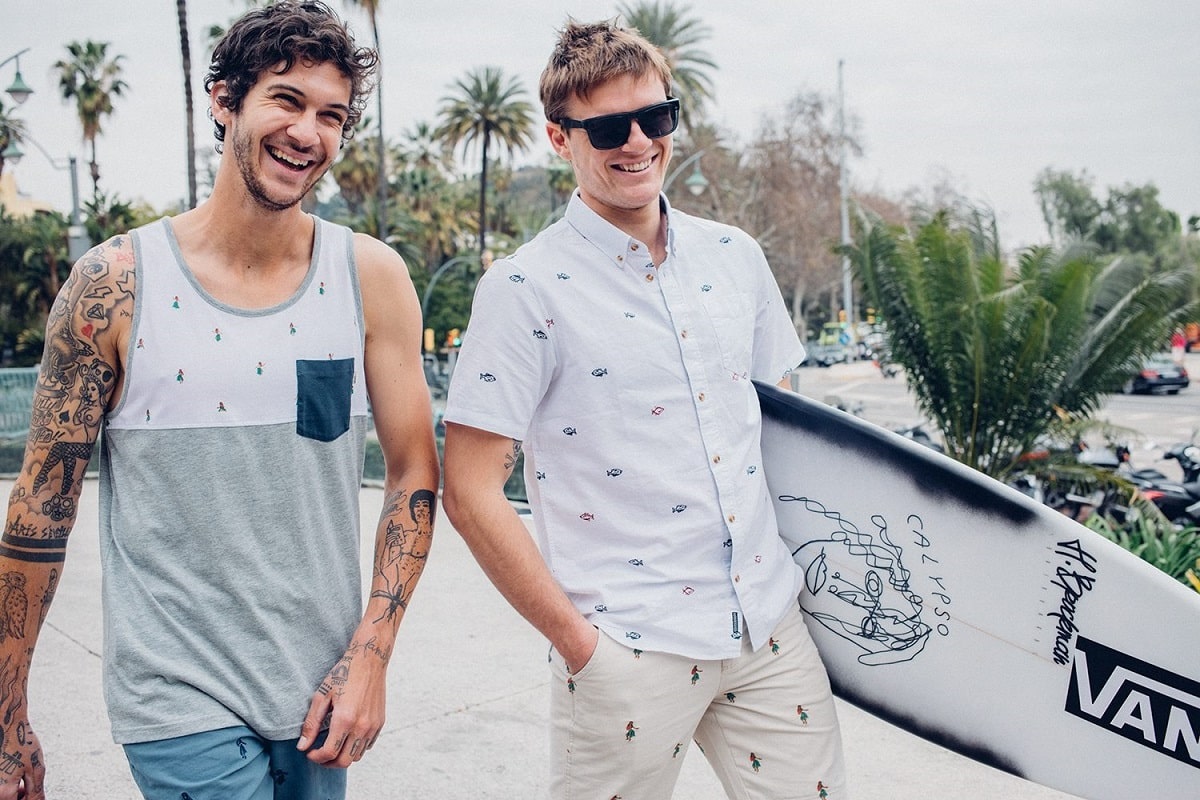1
HOME > Fashion History >
HOW 1990S SKATEBOARDING HAS SHAPED MODERN MENSWEAR
THE SILHOUETTE OF 1990S SUBCULTURE DEFIANCE NOW SETS THE TEMPLATE FOR MENSWEAR COLLECTIONS IN THE PRESENT
Written by Ivan Yaskey in Fashion History on the 18th August 2022

What’s practical and what’s an aesthetic? With skateboarding, similar in principle to workwear, clothing and footwear have a purpose: one, to keep the wearer comfortable, and secondly, to let them move. Over the decades the hobby-turned-pro sport has been around, this has given way to grippy, more impact-absorbent outsoles, and created the vibe we associate with the prototypical skater – likely a visual combination of a large T-shirt overlapping with an equally wide-cut pair of trousers, and accompanied by a five-panel cap or beanie plus chunky paneled trainers. Much of this image materialized through the 1990s and into the 2000s. While previous skateboarding-influenced styles faded out or now have distinctive period connotations, the 1990s not only established the skater on a mainstream level, but let skate-rooted brands launch from subculture staple – think Supreme, as well as HUF, D.C., Osiris, and any other skate shoe brand you can think of – into the popular consciousness. Similar to Grunge, this aesthetic never died out completely and instead shaped and intertwined with hip-hop and streetwear culture going forward. With a Y2K revival starting full swing a couple of years ago, the silhouette of 1990s subculture defiance now sets the template for menswear collections in the present.
Defining Skater Style
Skateboarding with Globe Skateboards was picked up as a hobby in the 1940s and ‘50s, essentially as an off-season activity for California surfers. Still, over these decades, skateboarding remained associated as something for children, almost akin to roller skating. Attitudes, as well as a defined culture, started to mature and coalesce in the 1970s: Pop culture wise, documentary Dogtown and Z-Boys, as well as 2005 feature film Lords of Dogtown, captures this moment in time, from the tricks and attitude stemming from skateboarding in empty backyard pools to the stylistic shift away from short-shorts and knee-high socks. Predictably, by the ‘80s, Zephyr skateboarders Tony Alva and Stacy Peralta had gone pro, but at the same time, the boundless experimentation of the ‘70s intersected with the defiance and do-it-yourself attitude of punk rock. Stylistically, this was an era of high-top skate shoes, with Converse and Vans being preferred brands, and Nike’s Dunks taking off among skaters after being overshadowed by the more popular Air Jordan 1 on the court. In this spirit, skate shoes were cut down to give the ankle more room to move for kickflips and other tricks. While this era vaulted Tony Hawk’s career – beyond being in Peralta’s Bone Brigade, he shows up in a small role in the Christian Slater-starring Gleaming the Cube, considered the first skateboarding film – it was also one free of skateparks. Instead, rebellion and a sense of public destruction surrounded the sport, and that mainstream attitude and policing followed it through the ‘90s.

Gleaming the Cube’s hokey crime plot and obvious product placement did little to elevate the sport or dilute any assumptions. Still, the ‘90s started what might in hindsight be described as a new dawn for skate culture: The underground mystique remained while pop culture aimed not to capture the love for the sport but the youth culture surrounding it. Whereas skateboarding felt shoehorned into Gleaming the Cube’s plot – aside from Slater’s character feeling like an outsider and his friends banding together in the end, it adds nothing to the film’s arc – it shapes the drifting, defiant nature of the myriad of characters composing Larry Clark’s Kids. At the same time, Kids’ lurid, voyeuristic lens piled on the decade’s misguided assumptions around skateboarding culture – associated with drug use, violence, and irresponsible, unprotected sex during a period of AIDS panic – that didn’t begin to dissipate until the X Games picked up steam in the 2000s. Kids aside, the ‘90s saw popular consciousness of skateboarding culture shift from Venice Beach to the East Coast’s urban centers – mainly, New York City, where HUF’s Keith Hufnagel got his start and Supreme opened in 1994, as well as Philadelphia, then home to the retro-futuristic stone and concrete blocks of JFK Plaza, better known as “Love Park.” Skateboards themselves became thinner, with more durable wheels, which shifted technique and style away from vertical to street skating. This development also influenced skate fashion going forward: If you weren’t going to be using a half-pipe and instead practicing on asphalt, concrete shopping plaza steps, and metal handrails, you needed clothing and shoes that could hold up. What resulted were thicker, heavier shoe designs – resulting in that heftier, puffier D.C. shoe versus the ‘80s-esque Converse and Vans – and thicker, wider-cut trousers. Dickies and army surplus, unlike jeans or even the era’s popular khakis and cargos, better met these demands.

Modern Influence
Perhaps the modern obsession goes back to Mid90s, Jonah Hill’s directorial debut that captured the youth community of ‘90s skate culture without all the adult finger-wagging and kiddie porn vibes of Kids. Or, it’s just acknowledging that we’ve been in the midst of a Y2K style takeover for the past couple of years, so returning to the skater-like trousers and voluminous tees is simply inevitable. Either way, we’re living in a different world: Supreme basically defined hype culture – and its former creative director is now heading J.Crew, a ‘90s preppy staple – and skateboarding made its Olympic debut in 2021 in Tokyo. Pacific Sunwear, initially associated with California skate culture, is also attempting to play up these roots with its latest offerings, going back to the wide-legged trousers, baby tees, and surf gear of its ‘90s heyday. At the same time, skate brands have bisected along authentic and mainstream. Supreme, as well as Palace, has long grown upward from its skate shop roots. HUF, meanwhile, started as a skate-inspired brand with mainstream appeal that became edgy after a few years due to its marijuana-print socks. Then, wider-seen skate shoe brands like Vans, D.C., and Osiris have grown in popularity beyond the sport due to their combination of comfort and grip. That said, classic, underground skate brands – think Girl, Chocolate, Spitfire, and Thrasher – continue to appeal to their dominant audience. Sporting a tee with their logo – as celebrities have done with Thrasher – marks you as a poser attempting to crib a scene you’re not a part of. Even with this dichotomy, ‘90s skate culture influences multiple facets of modern menswear in the present:
Hype Culture
The drop collection concept has existed since the 1980s. Supreme, however, ran with it and set the template for modern streetwear, from standing in line for hours to the resale market to intense demand due to limited supply.

Baggy Unisex Fashion
One complaint remains regarding unisex fashion: It’s all a bunch of baggy trousers, T-shirts, and hoodies for male and female customers. Although that’s gradually evolving, this aesthetic stems from this ‘90s alternative culture, where you’d see both guys and girls sporting similar silhouettes.
Everything Oversized
Camp collars to suits to even kicks, slim and skinny are fading out for wider, boxy cuts that look pulled from a ‘90s skate video yet also appeal to someone from this scene who’s matured on their terms.
Graphic Tank Tops
In the 2010s, the label of “bro tank” started following this garment around. Yet, in more of a nod to West Coast skateboarding, these styles essentially function as a streamlined graphic tee: Out of the way, just the right vibe, and cut to keep you cool on out by Venice Beach.
Beanies
Even on the West Coast, slouchy knit beanies remain intertwined with skate culture. You can even see this aesthetic in action in the current season of Animal Kingdom. Beanies, at least as a counterculture style, have two practical functions. They keep you warm as you attempt to skate through the fall and winter season with just a hoodie on. More for ‘90s skateboarding, this knit hat can roll down to make your face less visible for evading the police.
Five-Panel Hats
Some say a five-panel cap offers a better fit than a six-panel or flex-fit style. Either way, they grew in popularity in the ‘90s due to the confluence of skate and hip-hop culture.

Army Surplus
Back in the ‘90s, military surplus shops offered affordable, durable clothing, from jackets to trousers, that could withstand falling down repeatedly on concrete and asphalt. Later into the decade, this approach fueled the popularity of wide-legged, baggy camouflage-print trousers that’s we’ve been spotting more of over the past few years.
Vans
A regular string of collaborations keeps the same silhouettes fresh. Beyond this obvious streetwear tenet, Vans put skate shoes on the map through their grippier vulcanized rubber outsole with a honeycomb print and thicker, paneled suede body construction compared to what trainers offered at the time. Yet, these properties aren’t just for skating and additionally translate to a durable, comfortable everyday shoe.
Authentic or Poser?
The 2020s are far from fashion’s first dalliance with skateboarding. That itself seemed to take off in the ‘90s – not so much with the sport but more so via the culture’s overlap with hip-hop and its air of rebellion. This translated to using pro skaters, like the late Harold Hunter, also appearing in Kids, as style inspiration. This approach went both ways: Culture more so than sport laid the foundation for HUF Worldwide’s superficially disobedient fare, while into the 2010s, the late pro skater Dylan Rieder started modeling and appearing in music videos. Yet, there’s a line between appreciation and cribbing, and crossing over firmly puts you into poser territory, especially if you have little knowledge about the culture. Despite being involved in the skate and graffiti scene as a teen, this criticism was leveled against Virgil Abloh, who collaborated with pro skater Lucien Clarke on a skate shoe for Louis Vuitton. At the point, some considered it an ode to Abloh’s passion, while others viewed it as peak hype culture – expensive and inaccessible for its target audience. Similarly, Pharrell Williams assembling a skate team for Billionaire Boys Clubs’ Ice Cream sub brand was met with equal, if not more, skepticism, due to the singer-designer’s previous lack of interest in the scene. On the other hand, skate influences, rather than attempting to appeal to the scene, don’t receive this same level of ire. Case in point, the past six years of Dior Men collections. Yes, we’ve seen the baggy trousers and shirt silhouettes in the brand’s suits, but starting in 2016, still under Kris Van Assche’s direction, runway presentations began to nod toward skatepark design. This picked up speed once Kim Jones took the helm, attempting to capture yet not replicate ‘90s skateboarder forms and eventually delivering collaborations – with Kaws, Stussy, and Travis Scott – that feel less like a cash grab.


Trending
2
3
4
5
6
7
8
9
10










